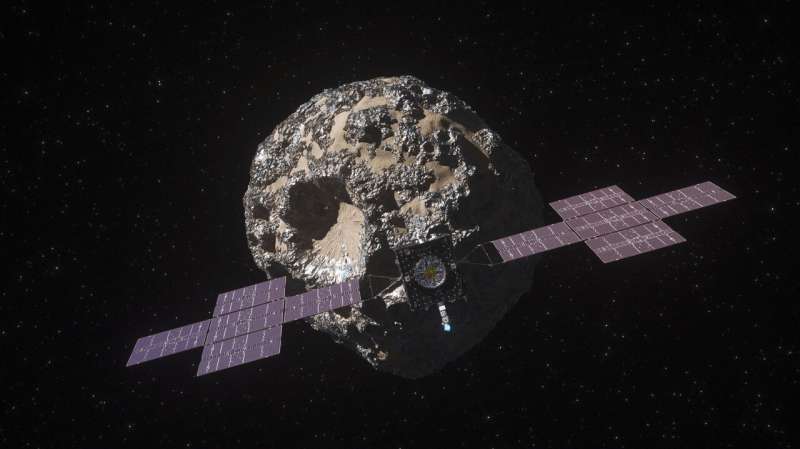This article has been reviewed according to Science X's editorial process and policies. Editors have highlighted the following attributes while ensuring the content's credibility:
fact-checked
trusted source
proofread
6 things to know about NASA's asteroid-exploring Psyche mission

The first-ever mission to study a metal-rich asteroid, Psyche aims to help scientists learn more about the formation of rocky bodies in our solar system.
With a launch readiness date set for Thursday, Oct. 12, NASA's Psyche spacecraft will travel 2.2 billion miles from NASA's Kennedy Space Center in Florida to a metal-rich asteroid in the far reaches of the main asteroid belt between Mars and Jupiter. Trailing a blue glow from its thrusters and powered by a pair of massive solar arrays, the orbiter will use its payload of science instruments to learn more about the asteroid Psyche.
Here are six things to know about the mission:
1. Learning more about the asteroid Psyche could tell us more about the origins of our solar system.
Based on data obtained by Earth-based radar and optical telescopes, scientists hypothesize that the asteroid Psyche could be part of the metal-rich interior of a planetesimal, a building block of a rocky planet that never formed. Psyche may have collided with other large bodies during its early formation and lost its outer rocky shell. Humans can't bore a path to Earth's metal core, so visiting Psyche could provide a one-of-a-kind window into the history of violent collisions and accumulation of matter that created planets like our own.
2. The asteroid could also suggest a different story of how solar system objects formed.
While rocks on Mars, Venus, and Earth are flush with iron oxides, Psyche's surface doesn't seem to feature much of these chemical compounds. This suggests that Psyche's history differs from standard stories of planetary formation.
If the asteroid proves to be leftover core material from a planetary building block, scientists will learn how its history resembles and diverges from that of the rocky planets. And if scientists discover that Psyche is not an exposed core, it may prove to be a never-before-seen kind of primordial solar system object.
3. Three science instruments and a gravity science investigation will help sort out these solar system origin stories and more.
The spacecraft's magnetometer will look for evidence of an ancient magnetic field at the asteroid Psyche. A residual magnetic field would be strong evidence the asteroid formed from the core of a planetary body.
The orbiter's gamma-ray and neutron spectrometer will help scientists determine the chemical elements that make up the asteroid—and better understand how it formed.
The spacecraft's multispectral imager will provide information about the mineral composition of Psyche as well as its topography.
The mission's science team will harness the telecommunications system to conduct gravity science. By analyzing the radio waves the spacecraft communicates with, scientists can measure how the asteroid Psyche affects the spacecraft's orbit. That information will help them determine the asteroid's rotation, mass, and gravity field, offering additional insights into the composition and structure of the asteroid's interior.
4. The spacecraft will use a very efficient propulsion system for the first time beyond the moon.
Powered by Hall-effect thrusters, Psyche's solar electric propulsion system harnesses energy from large solar arrays to create electric and magnetic fields. These, in turn, accelerate and expel charged atoms, or ions, of a propellant called xenon (a neutral gas used in car headlights and plasma TVs) at such high speed, it creates thrust. The ionized gas, will emit a sci-fi-like blue glow as it trails behind Psyche in space. Each of Psyche's four thrusters, which will operate one at a time, exert the same amount of force that you would feel holding three quarters in the palm of your hand. In the frictionless void of space, the spacecraft will slowly and continuously accelerate.
This propulsion system builds on similar technologies used by NASA's Dawn mission, but Psyche will be the agency's first mission to use Hall-effect thrusters in deep space.
5. Psyche is a collaboration.
The mission draws on resources and know-how from NASA, universities, and industry. The principal investigator, Lindy Elkins-Tanton, is based at Arizona State University. By enabling collaboration with students nationwide, the partnership offers opportunities to train future instrument and mission leads in science and engineering, and to inspire student projects involving art, entrepreneurship, and innovation. Over a dozen other universities and research institutions are represented on the mission team.
NASA's Jet Propulsion Laboratory in Southern California manages the mission for the agency's Science Mission Directorate in Washington. Managed for NASA by Caltech in Pasadena, JPL is also responsible for system engineering, integration and test, and mission operations.
NASA's Launch Services Program at Kennedy Space Center manages launch operations and procured the SpaceX Falcon Heavy rocket.
Maxar Technologies' team in Palo Alto, California, delivered the solar electric propulsion chassis—the main body of the spacecraft—and most of its engineering hardware systems.
6. The Psyche mission wants you to be part of the journey, too.
Space exploration is for everyone. The mission's "get involved" webpage highlights activities and opportunities, including an annual internship for college students to interpret the mission through artistic and other creative works, as well as classroom lessons, craft projects, and videos. Information on how to participate in a virtual launch experience is at nasa.gov/specials/virtualguest/.
The mission websites nasa.gov/psyche and psyche.asu.edu will post official news about the spacecraft's journey. NASA and ASU will also post regular social media updates on Facebook, Instagram, and X.
NASA's Eyes on the solar system, a free web-based 3D visualization tool, will track the location of the spacecraft in real time. Visit go.nasa.gov/45k0OVY to see where Psyche is in the solar system.
About two months after launch, as the team performs an initial checkout of the spacecraft and science instruments, the mission expects to receive its first images. Once the team confirms the imager is functioning as expected, a webpage will feature the unprocessed, or raw, images flowing straight from the spacecraft.
Provided by NASA





















